Timothy Beach
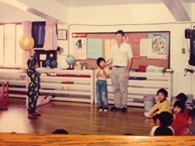
1994. I’m pictured here with Tiyia (my soon-to-be daughter), celebrating her 5th birthday in my Montessori class on the campus of Presbyterian Bible College in Hsinchu, Taiwan. The Presbyterian Church in Taiwan was founded by Canadian missionaries with strong ties to Knox College.
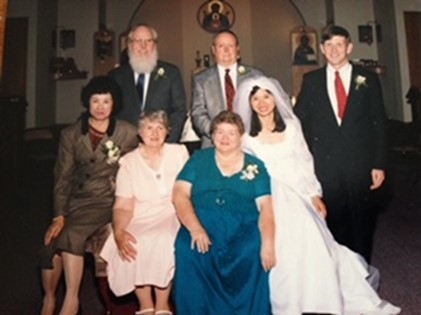
Anna’s and my wedding on July 9, 1995 at St. Paul Orthodox Church near Seattle. Photo includes Anna’s mother, my parents and my stepparents.
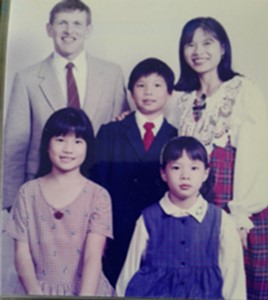
Beach Family 1996: Timothy 42, Anna 34, Justin 9, Sarah 8, Tiyia 7, and Nicholas (on the way
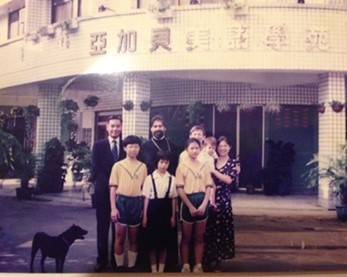
Metropolitan Nikitas (a Florida native) and his associate, visiting us from Hong Kong, at our Agape English Language School. c. 1998. He later sent a priest, Fr. Jonah, who is still pastor of Holy Trinity Orthodox Church in Taipei.
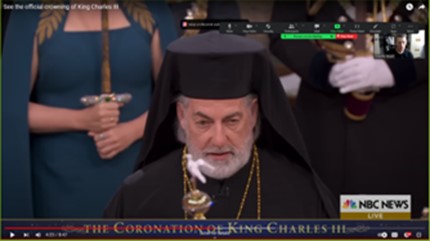
Fast forward about 35 years to see Nikitas as the Greek Orthodox Archbishop of the UK. In this photo, he is offering a prayer at the coronation of King Charles the III, May 6, 2023
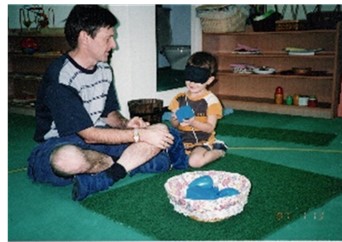
Montessori class, Taiwan; Nicholas (age3) receiving a lesson on the geometric solids. The goal is to identify each by feeling them only. (c. 2000)
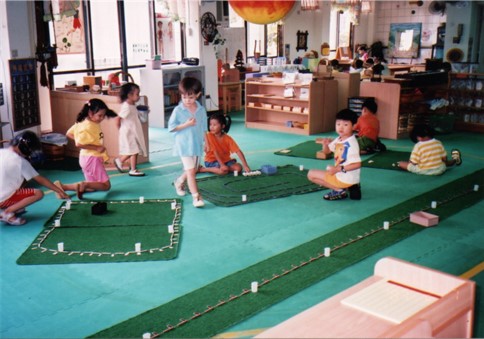
Montessori class, Taiwan: Nicholas (age 4) looking at classmates’ math work. (c. 2001)
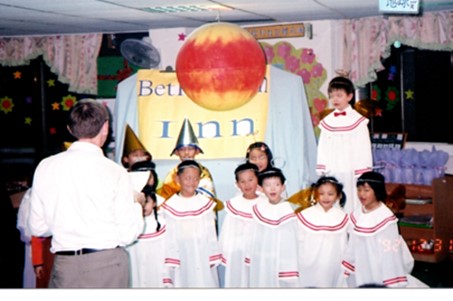
Montessori Class Christmas Pageant Choir
(c. 2002)
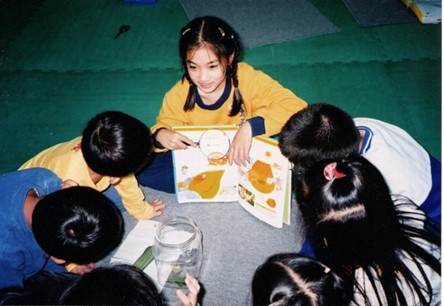
2003-2004. Some of Anna’s ages 6-9 students in her Montessori after-school program which she arranged in partial fulfillment of the requirements for her Lower Elementary Montessori Certificate and her M.Ed. degree from Xavier University in Cincinnati.
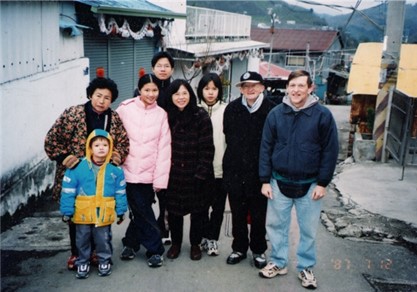
Beach Family visiting Catholic missionary priest Fr. Kevin Barlett (of Perth, Australia) at his parish in an aboriginal village in the mountains East of Taichung during the Chinese New Years holiday c. 2003. God blessed me with two miracles through Fr. Kevin. (See my bio for details.) Standing behind Nicholas is a tribal princess.
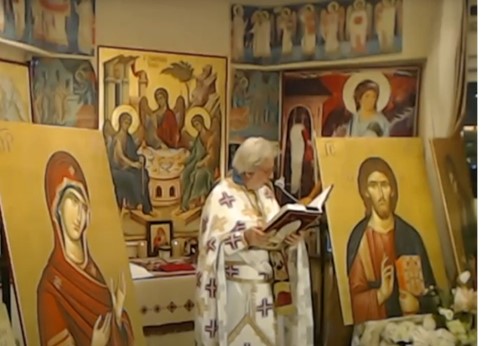
Fr. Jonah Mourtos, who was previously a monk on Mount Athos for 19 years. Here he is reading the Paschal Gospel in Mandarin. He has been serving in Taiwan for at least 26 years now.
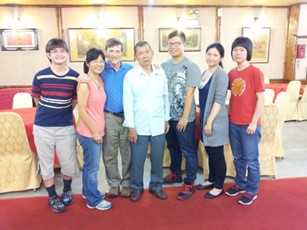
Our three “big kids” home in Taiwan from college / work in U.S. during summer (c. 2012) vacation; taking grandpa out to a nice restaurant.
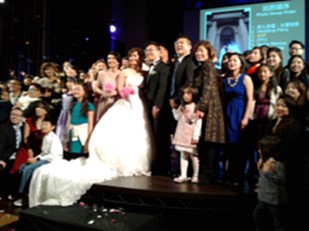
Justin and Ivy’s wedding, February 2017
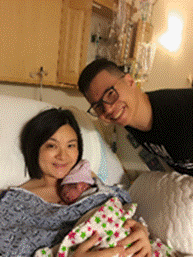
Emma, first grandbaby 03/2018.
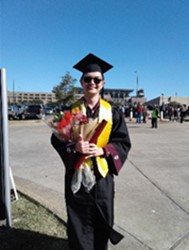
Nicholas’ graduation from Texas A&M Univ., College Station, TX, December 2018.
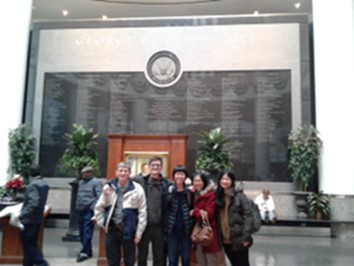
Nicholas’ big sisters flew in from California for the big day. Here we’re inside the George H.W. Bush (I) Presidential Library located on the A&M campus. Dec. 2018.
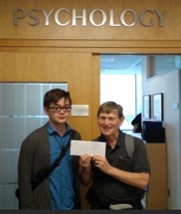
Nicholas and I hand-delivering a note of thanks to U of T Psych Dept. for Jordan Peterson (on leave) in 2019.
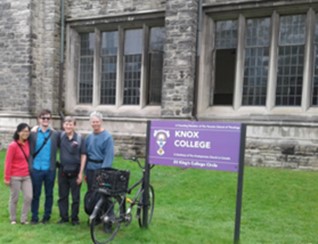
Anna, Nicholas, and I with my friend Deacon Paul of the Ukrainian Catholic Church in Toronto whom I met through the Orthodox Peace Fellowship. I was hoping that the Knox College Registrar could confirm that the Scots-Canadian missionary doctor-minister George MacKay had studied at Knox. But apparently records did not go back quite that far because a staff member could not find his. Photo – 2019
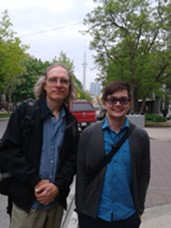
Nicholas with our friend, Gordon of St. Catherine, ONT. We met Gordon in Taiwan many years ago. Photo – 2019
In June, 2019, the day before Anna and I flew from Toronto, Ontario to Ontario, Cal., we set out on foot to explore the neighborhood around our hotel in Missasauga, and literally perchanced up a real treasure in the form of St. Elias Greek Orthodox Church. It was unlocked and the office staff graciously allow us to come in and look around. There we came across some of the most stunning iconography and iconographic stainglass that I’ve ever seen. Samples follow. (Of course my cell phon photography does not do these samples justice! (They’re best seen in person.)
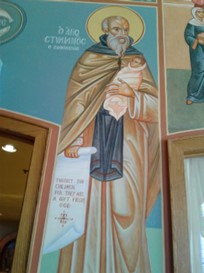
This icon is of Saint Stylianos of Paphlagonia. His scroll reads:
PROTECT THE CHILDREN FOR THEY ARE A GIFT FROM GOD.
This is certainly relevant advice for our times.
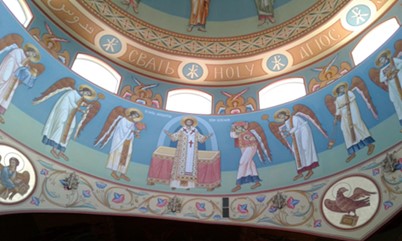
Part of the dome.
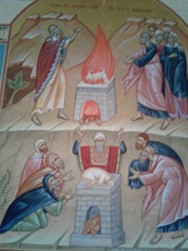
The Sacrificial Lamb
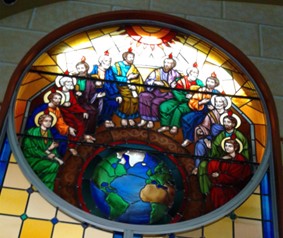
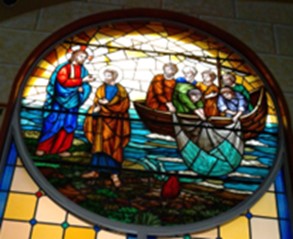
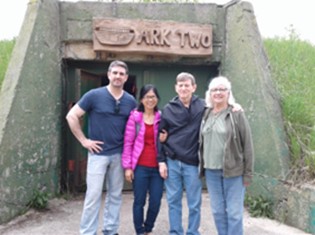
2019 Anna and I with my Godson (whom I baptized in Missistini, Quebec in Dec. 1979 during my Anglican days.) and his mom. We’re standing in from of my father’s famous Ark II bomb shelther in Hornings Mills, ONT
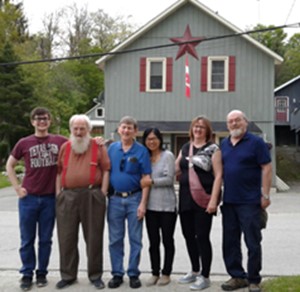
2019 – Nicholas, my father Bruce, myself, Anna, my sister Bahia and her partner, Glenn. Photo taken in Horning’s Mills. Bruce passed away in May 2021 at the age of 87, and my stepmother, Jean, passed the following April at the age of 94. As some of you knew, they were Baha’is.
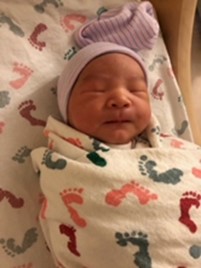
Newborn Elliott, February 2020
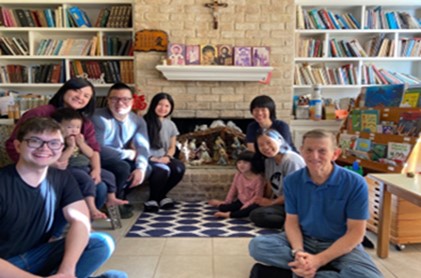
Thanksgiving 2021 in Houston. From left to right: Nicholas, Elliot, Ivy, Justin, Sarah, Tiyia, Emma, Anna, and Timothy
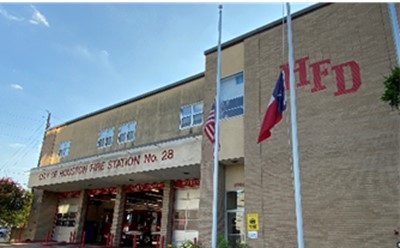
Sept. 13, 2022. Following the passing of Queen Elizabeth II, U.S. and Texas flags flew at half staff all around Houston for 30 days, including at this fire station near my school.
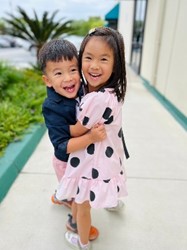
Elliot, 3 and Emma, 4 – July 1993
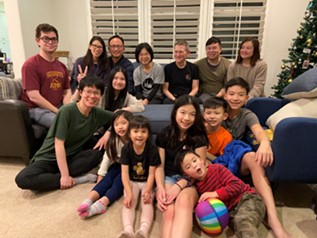
Christmas 2023 – Our family with Justin and Ivy’s pastor’s family. Emma and Elliot are front center.
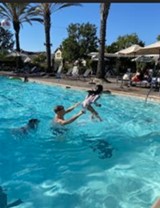
Throwing Emma in the pool – Cal. July 2024
Coaching Emma in swimming – California. July 2024
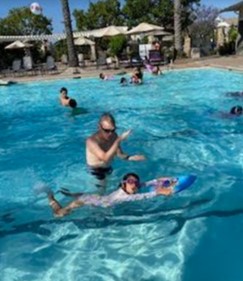
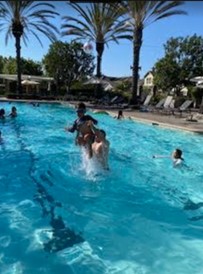
Throwing Elliot in the pool – California. July 2024
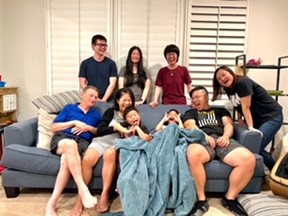
July 2024 (Silly) Family Photo – California, July 2024
B. Timothy Beach , October 26, 2024
Theological Reflections on
Lay Ministry, Cross-Cultural Mission, Work, and Christian Education and the Formation of Children
INTRODUCTION
Dearest Wycliffe College Graduation Classmates of 1979,
WARNING: This is longer than I planned it to be. Of course, after 45 years, there’s a lot to catch up on! If you’re retired and bored, this will give you something to do. If not, feel free to read it a little at a time. I’ve already read the 9 bios that have been posted so far. Mine will be the tenth if I get it before one of the remaining classmates beats me to it.
As you look through my posted chronological photo album, you’ll notice that there’s a big gap between 1979 and 1993 due to the fact that most of my photos from the earlier period are most likely still at a friend’s house in Washington State. I now live in metro-Houston to which my wife, Anna, our youngest child, Nicholas, and I moved upon concluding my twenty-year stay in Taiwan.
For the sake of the conciseness – a relative concept for which, by any standard, I do not have a natural inclination – I will attempt to bullet point major chronological events, and then conclude each section with a reflection in paragraph or bullet point formats. Please be aware that I may break from this format wherever it doesn’t seem suitable.
My main themes include: cross-cultural ministry, the ministry of the laity in the founding of new missions, and holistic health.
PRE-WYCLIFFE
As Paul as already noted, during our time at Wycliffe, we got to know a few classmates a lot better than others. As I was single at the time, I got to know some other resident students better than most of the ones who were married. But perhaps even many of my fellow residents never knew what brought me to Wycliffe in the first place. So, I’d like to begin with an overview of my pre-Wycliffe spiritual/educational journey.
Highlights
- My parents divorced when I was 6 and my mother remarried when I was 8. My father, Bruce Beach, also remarried. My stepmother, Jean, was Canadian and Baha’i. They and my 3 half-siblings lived many places in the U.S. and Canada. My father, raised Christian Scientist, also became a Baha’i.
- Between ages 4-15, we (mainly my stepfather, mother and siblings) lived in Kansas where my family’s participation in church was sporadic. My mother church-hopped sometimes. But we mostly attended the Methodist church where I was baptized at age 12.
- Moved to Seattle at age 15, then, six weeks later, to a rural area outside Everett, WA where we went to a community church and where I was baptized again by the Jesus People.
- Moved back to Seattle just before my senior year of high school.
- Entered Univ. of Washington in Fall 1972 and enrolled in Air Force ROTC.
- Went to various churches. Settled at a large Pentecostal church. In 1973, just before starting my second year at UW, received baptism in the Holy Spirit and gift/manifestation of tongues.
- 1974 – transferred to Oral Roberts University in Tulsa, OK. Majored in NT.
- In Tulsa, visited Catholic and Episcopal Churches for the first time.
- Summer 1975 – Visited charismatic Episcopal church in Seattle, St. Luke’s. The rector was Fr. Dennis Bennett – a great pastor, and a good friend of the Rev. Ron Armstrong, a Wycliffe grad. and rector of Emmanuel Church in Thornhill where I later assisted on Sundays during my first two years at Wycliffe.
- 1975-1976 – Taught 4th grade church school at St. Dunstan’s Episcopal Church.
Was received into Episcopal Church in April 1976.
- Rector in Tulsa gave me an ad from the Episcopal newspaper advertising Wycliffe. Student pictured in the ad was Michael Stonhouse. This was a remarkable coincidence since my father worked in Toronto at the time.
- Right after my graduation from ORU, Bruce and I flew to Toronto via Chicago.
- While in Toronto, we visited Wycliffe and I met Dr. Stackhouse.
- The only obstacle to me attending Wycliffe in the fall was money. I didn’t have any. So, I went to work for Sears which I had worked for before.
- Later, Dr. Stackhouse called me to tell me that that they obtained some scholarship funding for me. Fr. Benett and the other clergy at St. Luke’s felt that this was a sign from God that I should go. And so, I did.
- Many, many years later, Bruce told me that he had had a meeting with Dr. Stackhouse and told him that he sometimes had money and sometimes didn’t. But he just happened to have a significant amount of cash on hand at the time and wanted to secretly contribute it towards my fees. And that’s how I arrived at Wycliffe.
Reflections on this period of my life
With regard to my charismatic experience, in my case, it was a very powerful and undeniable experience. I knew the difference between me trying to speak in tongues and the Spirit speaking through me. However, over the next 15 months, my experience of glossolalia gradually decreased, with my last experience being just before flying back to Seattle for Christmas vacation in 1974. During the next several months, I experienced sort of a mild form of depression perhaps, thinking that God had abandoned me.
Three lessons learned:
- As St. Paul states, the charisms of the Spirit may be gifts or they may be manifestations;
- We sometimes need to be reminded that we must learn to love the giver of the gifts more than we love the gifts. (This is true whether the giver is God or our fellow humans.)
- God gives us spiritual gifts for the purpose of drawing us closer to Him and making us holy. If we’re not growing in growing in attentiveness and obedience to God’s voice and in spiritual disciplines, then we’re not utilizing His grace and gifts for their intended purpose.
For those of you who took any classes from Fr. George Montague at St. Michael College – especially his course on the Holy Spirit – his books on Confirmation in the Early Church are worth taking a look at! The shorter version is only 30 pages: Fanning the Flame – What Does Baptism in the Holy Spirit Have to do with Christian Initiation? It’s available here as a downloadable ebook for $US 3.99.
The 342-page version, CHRISTIAN INITIATION AND BAPTISM IN THE HOLY SPIRT – Evidence from the First Eight Centuries –second edition, is available at the same site for a hefty $47 (ebook) or $49 (print) price tag. Or you can get the first edition – which also has 1991 copyright date – for under $9 if you don’t mind it being second hand. I chose the latter option.
I got to hear Fr. George’s co-author, Fr. Kilian McDonnell, speak on these two books in Taiwan in 1994.
To conclude this section, it seems to me that the Catholic Church has taken the most balanced position on the movement of the Holy Spirit in the church. Many Pentecostals go off to one extreme, and many other churches go off on the opposite, anti-Charismatic, extreme – which they may do because the extreme practices of some Pentecostals give mainstream churches a rationale for throwing the proverbial baby out with the bathwater
POST GRADUATION
Northern Quebec and Northern Ontario
The Summer of 1979 was the second consecutive summer that I spent working at a mine in Matagami, Que. four days per week while doing church work in the evening and on Friday through Sunday. In the Fall, I was ordained a deacon and sent to Mistissini (aka Mistassini) Cree Reserve to assist the Rev. Jim Collins who was also from the U.S. Eventually I was transferred to Waspanipi, Que. to take over for a retiring Cree priest. In the Fall of 1980, I was ordained a priest and then returned to Waswanipi where I celebrated Holy Communion and Morning Prayer from the Cree BCP and in English, and gave homilies in English and a couple of times in French. I was also using a Cree textbook, written in French, to learn conversational Cree. On both reserves, the Pentecostals were rapidly growing. They did much in Mistissini to curb alcoholism, and were starting to do the same in Waswanipi, but there was still had a long way to go.
I became rather lonely in Waswanipi, but was slow to recognize this. I recall Dr. Flint’s recollection of being a newly ordained deacon, and being dropped off of a ship upon arrival in Baffin Island in the Arctic with a year’s supply of food, and not seeing another person from his own culture during the interim period. He said then he understood why Jesus sent the apostles out two by two – even in their own culture setting – because the Gospel is best presented in the context of Community.
After being transferred to Timmins for a few months, and later being offered a possible transfer to Montreal – which would have been very interesting for this Francophile! – I declined, but often wondered how it would have turned out for me if I had taken that other path at the fork in the road. In the end, I felt I needed to get a regular job and then sort out what kind of ministry I was suitable for.
Reflections Ministry and Missions to Indigenous Peoples
Appointing poorly prepared and unqualified native catechists, readers, and priests is a recipe for disaster. Bishops may get away with it if there is little in the way of competition. Question: Which of the following will win in the short-run: heresy proclaimed with conviction and enthusiasm, or truth muttered incomprehensibly and without feeling? I’m intentionally offering an extreme example to make a point. I’m not accusing the Pentecostals of heresy, but only attributing much of their success to heartfelt conviction and an eagerness to share the Good News, as they understand it, and as it has blessed them. In the meantime, traditional/liturgical churches need to make their spiritual treasures both emotionally and intellectually accessible to all.
Similarities Between Anglican Missions in the Canadian North and Orthodox Missions in Alaska
[Note: The following remarks about Alaska are based on what I’ve read or heard. I’ve never visited there.]
In both the Canadian North and in Alaska, the Anglican and Orthodox churches assigned readers to conduct services in the absence of a priest or deacon – a remarkable similarity for two churches that share little in the way of recent history. In Alaska, the Russian Imperial Missionary Society continued to fund about 30 schools in Alaska even after its sale to the U.S. in 1867. But the funds were cut off in after the Revolution of 1917. The Orthodox Church in America founded St. Herman’s Seminary in 1973 in Kenai, 50 years after all of the previous schools were closed. St. Herman’s was moved to Kodiak the following year. https://sthermanseminary.org/history
Perusing the following map of parishes in native Alaskan communities will give one additional instant insight as to how amazingly similar the mission situations were in the 19th century for both Russian missionaries in Alaska and British missionaries across Northern Canada. After you click on the link, you must click to enlarge the map. Then you’ll see a red dot representing each parish or mission, most of which are accessible only by air – as is also the case for many mission parishes in the Canadian north. In Alaska, even the state capital, Juneau, is only accessible by air or sea!
https://www.oca.org/parishes/diocese/ak
It will not likely surprise you to hear that alcoholism has also been a major challenge in Alaska. However, it may indeed surprise you that – as I discovered years later – that it’s also a problem among the 14 Indigenous tribes in Taiwan – especially since you’ve unlikely ever even heard of Taiwan having indigenous tribes until just now! These people are non-Han Chinese who migrated to Taiwan hundreds of years before the first Han Chinese arrived from Fujian Province less than 400 or years ago. (See the photo of my family and Fr. Keving posing with a member of one of those tribes.) While receptivity to the Gospel has been slow among the Han Chinese – with only about 5 percent of the population professing the Christian faith in Mainland Chinese, and slightly less in Taiwan, perhaps 90 percent of the Indigenous peoples are Christian (Roman Catholic or Protestant).
So why is there a higher rate of alcoholism higher among aboriginal peoples in the U.S. Canada, and Taiwan? After I returned to Seattle from Canada, I came across a newspaper article written by a local doctor who ran his own well-known alcoholism rehab clinic. In the article, he explained that all tribes of people start off with a genetic intolerance for alcohol, and that it is only after alcohol has been part of the culture hundreds of years or more that a people group will begin to build up a genetic tolerance for it. Hence, there is a higher rate of alcoholism in northern Europe than there is in southern Europe which has had vineyards for quite a long time. (To the best of my knowledge, Scandinavians still lack vineyards, if you can imagine why!) As someone who belatedly discovered having lactose intolerance, I found it interesting to learn that there’s a similar pattern here: the rate of lactose intolerance is higher in northern Europe than in Southern Europe. Fortunately, while drinking milk may cause GI discomfort in people like me, I’ve never heard of it causing impaired judgement as alcohol does. In recent years, two major studies on the supposed health benefits of drinking wine – one at the University of Washington in Seattle, and the other at Oxford University – have both concluded that there is no net health benefit to drinking wine – much less any other alcoholic beverage! And to add insult to injury, can you guess which countries have the highest rate of binge drinking? The study I saw a couple of years ago concluded that it was the major English-countries: UK, US, Canada, and Australia. However, these international stats seem to fluctuate from year to year.
An Alcohol Counselor training program was started at St. Herman’s around 1985, and has since evolved into a program for Substance Abuse Counseling Training.
[See under “Fieldwork” here: https://sthermanseminary.org/program-of-study]
Obviously, this is a very good step. But my prevention orientation leads me believe that perhaps we’d do better generally – and in certain environments especially – by limiting our alcohol consumption to that which we receive in the Eucharist. I recall one of our upper-classmen at Wycliffe (a recovering alcoholic) who had said – and I’m paraphrasing – that the only alcohol that God allowed him to drink without him getting sick was consecrated wine. As one who has been blessed with tastebuds which never acquired a taste for either coffee or alcohol, consecrated wine on a communion spoon is the only alcohol I consume – and I really don’t feel that I’ve missed anything. This view became part of my evolving philosophy and practice of holistic health – Body, Mind, and Spirit – which acknowledges that compromised health in one dimension can affect our health in another dimension. (More on this below.)
- While researching future career possibilities, I discovered the field of EEG technology, went to meet the EEG tech in his lab at St. Mary’s hospital in Timmins where I had routinely visited parishioners who were in-patients.
- Found informal, on-the-job training (with no tuition cost, but also no salary) back home at the University Washington Hospital in Seattle, and was accepted. (Dr. Stackhouse graciously wrote a recommendation for me.)
- As soon as I returned to Seattle, I started visiting Orthodox churches.
- During the summer of 1983, when I turned 29, my 35-year-old neighbor and I took swim lessons at the local pool. In the beginning, I was exhausted after swimming only two lengths of the pool because I hadn’t learned how to turn my head to the side to breathe. I focused on mastering this skill. Consequently, within two months, I was able to swim a half-mile, and within four months a full mile. This experience had a positive experience on my life, but also gave me future new part-time and full-time employment options.
- After a year of training, I was offered a position at a hospital in the logging town of Aberdeen, WA which I started in Nov. 1983.
Soon after I arrived in Aberdeen, I took a lifeguarding class, then a Water Safety Instructor Class, and within less than a year after learning to swim correctly, I was teaching swimming in the evenings for the local Red Cross program. By age 31, I had learned to swim the butterfly, and eventually worked up to swimming it for over a mile, which I could still do into my early forties. Aquatics became a regular part of my life both for exercise. My transformation from shunning exercise to embracing it had really begun while I was a student at Oral Roberts University where the motto was “Educating the Whole Man, Body, Mind, and Spirit.” Regular PE classes and regular aerobic exercise were required there. Never having shown a talent for athletics – some forms of which present a high risk for injury – I’ve long preferred activities that are more likely to put me into shape than those which risk putting me out of shape!
While working in a hospital every day, I noted that some patients’ physical appearances didn’t match their chronological ages – some for better and some for worse! As many of us have learned or observed, ministry and other service vocations can be hard on our health – if we allow it to. Years ago, I came across a book written by a Lutheran doctor. She noted the poor status of health among clergy in general. During that same period, I heard from a Methodist pastor that, in his denomination, the most frequently prescribed medication for clergy was for stress or anxiety.
Now that I’m not teaching at a school anymore, I’ve joined the same gym that I previously couldn’t find the time to use, and am back to swimming, working out on the elliptical, and, at home, using the $150 weight set that I bought during the 2023 Thanksgiving vacation. [Warning: commencing a new plan of exercise should be done under the advice of a doctor!] What a difference it makes in terms of sleep quality and energy level! Later, in Taiwan, I also discovered that easy access to fresh vegetables and fruit made it easy to follow the Orthodox vegetarian fasting periods. In fact, in 1998 I basically started following a vegetarian diet year-round, and a few years ago, essentially became quasi-vegan. And I was certainly not the first person to discover that they felt better during Lent!
- I worked in EEG and related fields for about five years which, for the most part, was interesting and rewarding. I also earned an Emergency Medical Technician (EMT) certificate at that time to enhance my usefulness in the hospital which needed my EEG skills even though there weren’t that many EEGs to do. So, I also did EKGs, helped the respiratory therapists with some routine tasks, and taught CPR to the nursing staff. Once they sent me up to the Quinault Indian Reservation on the Olympic Peninsula to teacher a CPR class there.
- In the meantime, I had begun exploring Orthodox Christianity. In 1985, I informed my former bishop that I wished to resign my Anglican orders. In January 1986, I was received by chrismation (confirmation) into the Orthodox Church through the Antiochian Orthodox Archdiocese of North America. The following year I was ordained (“tonsured”) a reader.
- Later, I began feeling a yearning to return to cross-cultural missions. While working as a sleep studies technologist at a hospital near Seattle Univ., I enrolled in a four-quarter Teaching English as a Second Language post-bachelors’ certificate which I completed in Aug. 1988.
OFF TO HARBIN CHINA (1988-1989)
Later that month, I boarded a plane bound for Beijing. A few days later, I got on a train for Harbin (in Heilongjiang Province) which was a Russian built city. It boasted 22 Orthodox churches which were all closed during the Cultural Revolution. The city’s center piece, the wooden St. Nicholas Cathedral, was located in the middle of the city’s main traffic circle. It was burned down one night in a frenzy incited by a group of Mao’s Red Guards. Here’s a photo of it and also a photo of replica built outside the city in 2009.
Upon arrival, I was met at the train station by an interpreter from Harbin Shipbuilding University (now called Harbin Engineering University). There I taught ESL to students from various parts of China and also taught a class for professional adults. I found out that my M.Div. not only got me a higher pay (US$900 per month instead of just $500!), but also helped me get the job; the administration apparently believed that someone with a religious faith may better control their behavior and not cause a problem for them. The English Department Chair even asked me to give an evening lecture on the Bible. I also got to show the movie the Chariots of Fire to my students. By the end of the academic year, the social and political climate would change significantly.
I had become interested in the idea of rebooting Orthodox missions to Chinese, but first wanted to see what the situation was like with the only functioning Orthodox parish church in a Chinese environment. Harbin was originally a Russian rail city established in Heilongjiang Province, which borders Russia and was the area which was historically dominated by the Manchus. Many white Russians fled there after the Bolshevik Revolution, causing the city’s population to surge. A few years after the Cultural Revolution ended, the government allowed the Church of Holy Protection (originally built for Ukrainians living in Harbin) to reopen for the members of the church, and for foreigners, but not for regular Chinese who had no familial connection to it. In fact, there was a sign posted outside the church informing regular Chinese that this was a church designate for foreigners. Here are some photos of it of the church.
Fr. Gregory Zhu was the pastor. Another Chinese priest, Fr. Mikhail Li and his wife, came up from Shanghai to serve in the Church in Harbin only a month or so after I had arrived. He was a very spiritual man with a gentle disposition. He was very patient with my meagre Chinese. Both he and Fr. Gregory only spoke Chinese and whatever Russian that they remembered from the days before the Cultural Revolution when sent to work labor camps.
Following the student and worker protests which culminated in the Tiananmen Square Massacre, he was more hesitant to talk to me in his home, and was more cautious as to what he would say to me (a foreigner) even in his office. He would just say that he trusted in God. Here’s an interview with Fr. Mikhail after he immigrated to Australia. He passed away not long after. https://orthochristian.com/78385.html
As the protests spiraling toward their forthcoming cataclysmic climax, one of my students padlocked the classroom door so that none could attend class. At one point, I had heard that there was going to be a big protest in front of the provincial government building. So, I rode my bike over there with camera in tow. I sat down at a stone picnic table across from the government buildings and began writing a letter to my grandmother. In the meantime, two uninformed police officers walked by. One drew the other’s attention towards me, but they both kept walking. A few minutes later, a young uniformed officer informed me in English that I should follow him and his plain-clothes colleagues – one of whom just pick up my bike and carried it ahead. So, not seeing any other options, I followed them down the block a short distance to a gate in the long wall that I had been sitting in front of. Upon entering the gate, I discovered that, what was behind the wall, was the police headquarters. After getting some basic information from me as to who I was and where I was teaching, I was informed that I should not be taking pictures of students protesting, etc., etc. Then they returned my bike and said that I could continue writing my letter to my grandmother. Instead, still quite rattled, I high-tailed it back to my campus where I took out the film from my camera and hid it. I was afraid that they were going to report me to the school’s administration or to the Party official on the campus – but none of that happened.
As the days passed, things calmed down somewhat. We never returned to class, though. And then I discovered another trigger of Chinese wariness of foreigners. Apparently, when some kind of societal disruption occurs, there was a tendency to blame foreigners for the problem. I experienced two incidences that could be attributed to this cultural tendency. First, one day I was standing outside one of the dorms on the campus and talking to a student (who was an ethnic Manchu) who was not in any of my classes. While we were chatting, a bottle – apparently thrown from a dorm window – landed just in front of us. The student advised that we should move along. On another day, a Russian man and I went downtown to look at Harbin’s famous traditional Russian architecture, including apartment buildings about 3-storey’s high and painted in a soft yellow with white trim around the windows. While we were looking up and admiring the building’s design and style, a tomato landed at our feet. While I can’t know for sure why these two incidents happened when they did, I can say for sure that nothing like that happened to me before the protests started.
At risk of stating the obvious, by the end of the year, it seemed rather clear that any revival of an Orthodox mission to Chinese people was NOT going to start in China. So, I began thinking pondering Taiwan.
After my arrival in China, and while waiting for the day to catch the train to Harbin, I looked for the famous Chinese Ancient Observatory constructed in the 15th century, to which Jesuit priest Mateo Ricci gifted more accurate astronomical devices. But because it was hidden behind some other buildings, I never found it. And, when I tried again on my way out of China, the streets and sidewalks around the Observatory were blocked off because that area had been the scene of a major battle between students and the police just a couple of weeks before. But I did take a trip out to see the Great Wall. It was awesome to stand on it and to look up and down the path on top of the wall as it followed the contour of the hilly terrain on which it was built. [A piece of trivia: The mortar used to keep the bricks in the Wall stuck together was…rice! It was cooked on the construction sites.]
After the government’s crackdown, it blocked satellite transmissions of CNN and other news outlets. This led to journalists to become more resourceful. Inside the airport, an Asian-America lady from CNN approached me and asked if I were flying to L.A., because she needed to get the video that she was holding to a colleague who would be waiting for it in L.A. I replied that I was going to San Francisco, but that there was a Canadian fellow, who had walked ahead of me, who was going to L.A., and that I was sure that he would be willing to deliver it. She gave it to me and I gave it to him, and we said goodbye.
BACK IN SEATTLE (1989-1993)
Not long after I returned to Seattle, a small group of twenty-somethings took a weekend trip to the Vancouver area to visit an Orthodox mission there. When they returned, one approached me and said, “Timothy, we met someone in Vancouver who knows you.” I replied, “Really? Who?” “Fr. Lawrence Farley. He’s an Orthodox priest now” was the reply. “What? Really?”, I reacted in shock. Furthermore, they told me that his bishop would be visiting the parish soon and they were planning on taking another trip up and asked if I wanted to go too. So up we went, and I stayed with Fr. Lawrence, Donna, and their two daughters who were fairly young at the time. I also met a very talented retired doctor who painted icons, and built a chapel in his back yard from bottles and bricks where Fr. Lawrence held Liturgy at that time. It was a great reunion!
Between 1989 and 1993, I first worked for one school year at a Montessori school as a van driver and as a classroom assistant. Two evenings per week, my Montessori teacher-trainers drove to that school to hold Montessori teacher training classes for those interested in working with children ages 3 to 6. Later, I got a job in the aquatics program at a state institution for developmentally delayed adults, working afternoons and evenings from Sunday through Thursday. This allowed me to work at my teacher-trainers own school on Fridays. The trainers (a Presbyterian minister and his wife) introduced me to the Acting Director of the Early Childhood Teacher Education Dept. at Presbyterian Bible College in Taiwan asked me to come help supervise student-teachers Montessori internships. And so, I agreed.
FLYING TO TAIWAN – JULY 1993
After my teacher-trainers’ Taiwanese summer students finished the academic portion of their pre-primary Montessori teacher training program, we all boarded the same plane bound for Taiwan. Upon arrival, those of us who were headed to Hsinchu boarded the Presbyterian Bible College van, and we arrived on the campus about several hours later.
Presbyterian Bible College (likely closed now) was a lay training institution of the Presbyterian Church in Taiwan which was started by Canadian missionaries, and had close ties to Knox College. Most famous of the missionaries was The Rev. Dr. George MacKay – a dentist who studied theology at Knox College. U. of T. from 1865-1867. He learned the Taiwanese language (also called Hokkien or Southern Min Dialect) which is the same language spoken in the city of Xiamen located directly across the Taiwan strait from Taiwan. (It’s also my wife’s first language. As was typical, she didn’t start learning Mandarin until starting first grade. Mandarin came to Taiwan with the arrival of Chang Kai-shek and his Nationalist army. It is now the dominate language on the island.) You can read about George MacKay here.
https://en.wikipedia.org/wiki/George_Leslie_Mackay
Another major Chinese language spoken in Taiwan is Hakka. A few days after I arrived, I was invited to a joyous celebration of the release of the new Hakka translation of the Bible – or perhaps only the NT. The translation committee continued to periodically gather at Presbyterian Bible College (PBC) perhaps for the translation of the OT. The lead translator was another Knox grad, the Rev. Paul McClean whom I met several times. You can read about him here.
https://pccweb.ca/missionblog/2019/05/12/in-honour-of-the-bible-translation-teams-i-serve-in-taiwan
The translation’s first edition was a Romanized version so that was quite precisely phonetic. A second edition used Chinese characters, but followed Hakka grammar and syntax. In Taiwan alone, there were about 5 million Hakka speakers. (My wife’s sister-in-law is Hakka.) Hakka are – racially – a Han Chinese group, but they their own language culture and customs, and tend to stay close to their group. Both Catholic and Protestant missions found them to be the most challenging to evangelize.
The pastor who invited me to the translation release event was himself Hakka. (His wife was one of my interning teachers.) He spoke Hakka, Taiwanese, Mandarin and English. His Presbyterian church was only a short walk from the PBC campus. So that was the church I started attending. The pastor preached in Taiwanese and a quite scholarly high school teacher translated his sermon, sentence by sentence into Mandarin. (The translator’s wife was another one of my interning teachers.)
Another American, named James, arrived on the campus several weeks after I did. He came to teach English to the college students with whom I had little contact, as my job was to supervise the interning teachers in the Montessori class in the morning, and to give large group English lessons to the children in the traditional pre-school classes in the afternoon on a rotating basis.
On the first Sunday after the college students arrived, several attended the church near the campus. The pastor asked some of the students to stand up and introduce themselves. One attractive young lady stood up to speak. I leaned over and asked James who she was. Then he summarized her tragic story. Here I’m filling in some of the details that I later discovered. Her husband was a Presbyterian pastor in a small church in a Taipei suburb. He joined others to attend a church conference in Atlanta, GA, and ended up being one of four people who died from their injuries when their rental van rolled over and down an embankment. He left behind a wife (Li-chin/Anna) and three children: a boy, (Young-sheng / Justin), age 6, a girl, (Mi-er / Sarah), age 5, and a girl, (Ti-yia), age 3 1/5. I later discovered that her husband actually died in surgery in Grady Memorial Hospital in Atlanta – where my mother was born in August 1934. Eerie, yes. So, I did not meet her that day in August, as she was still very much grieving. However, a couple of months later, I did bump into her in a lane and she pointed me out to Mi-er, because I taught her English to her kindergarten class a couple of times per week.
On Christmas night, there was a special dinner at the church. As I approached the church, I saw Li-chin (Anna) sitting in her car with all three children. I asked her if she was going to come in, but she still seemed undecided. So, I went in, and she later came in with the children. Long story short, in spite of her English being quite poor and my Mandarin even worse, and the challenges of a cross-cultural romance and belonging to two different churches, we married a year and a half later at St. Paul Orthodox Church in suburban Seattle on July 9th, 1995. During that summer, Li-chin also took the academic portion of the Montessori teacher training course. In fact, nearly all of her summer course classmates, the teacher trainers, and her mother attended our wedding – in addition to my family and friends from various parts of Washington State, from Kansas, and from Ontario!
- 1995-1996: Anna (Li-chin), the children, and I returned to Hsinchu where Anna returned to PBC to continued her degree program in Early Childhood Education while I taught English at home.
- 1996-1997: The three children are all now in elementary school. I taught for one year in a combined private vocational high school / junior college. Nicholas was born in Feb. 1997, and Anna graduated in the Spring
- Nov. 1997: We moved into large, 4-storey townhouse at the edge of Taichung City.
- March 1998: Opened afternoon-evening language school.
- In early 1999: Since I had already been ordained as a reader, our Metropolitan recognized me as self-supporting lay missionary, and gave me permission to hold reader’s services in Taichung which I did for a while. At the same time, we started the process of “Expeditious Naturalization” for Anna and my three adopted step-children. As we all know, the wheels of government bureaucracy grind slowly. And when the FBI is 50,000 fingerprint checks behind while implementing a new automated system, it grinds even slower than usual.
NATURALIZATION & AN EARTHQUAKE!
(Well, we had experienced many of them, but none like this one!)
On Tuesday, Sept. 21, 1999 at 1:47 AM, we were roused from sleep with a 7.7 earthquake. With bookcases falling over, we raced to grab Nicholas and herded the whole family under a doorway in the living room. Our strong U-shaped group of 4-story townhouses withstood the quake just fine. But many buildings did not. See photos.
https://www.alamy.com/stock-photo/921-earthquake.html?sortBy=relevant
We didn’t know any of the 2,415 people killed or 11,305 injured, but one student’s family was particularly fortunate to get out of the building in time before it sank into soft land.
Due to the occurrence of intermittent aftershocks, we spent the next several nights sleeping in our tents on the playground of the nearby elementary school. We decided that since we couldn’t hold classes, we could try to push to get Anna’s fingerprints processed earlier. With the help of a lady who walked Anna’s fingerprints through the checking process and, later, a retired judge who intervened for us after we showed up late at the Federal Courthouse in Wichita, Anna and the children got the citizenship papers, then we dashed to the Wichita airport to fly to L.A. where I had already made passport appointments for the next day. Shortly after returning to Taiwan, we were back to teaching.
SCARIER THAN THE EARTHQUAKE
Prior to moving to Taiwan, the riskiest experience I had in my life was allowing some men in Waswanipi to convince me to bury two dearly departed persons in graves located on the other side of a lake during the spring thaw! This required loading caskets and sleds into boats, piloting the boats to the ice-covered lake, loading the boats onto the sleds, and following the lead man as he tested the ice each step of the way with a pole so that no one, hopefully, would fall through the ice.
When we arrived at the open water, as I recall, we left the sleds where there were, and piloted the two boats to the bank. By this point the wind had pick up, and it looked like we were in for some freezing rain. The men divided into two groups: one built a campfire for hot tea and the other dug the graves. As soon as the grave had been dug, the caskets were lowered in. I prayed the burial prayers. Then the graves were filled in with sand, loaded the boats and we all jumped in as dusk and clouds turned the sky darker and the wind blew even harder. After we arrived at the large ice patch, we did everything in reverse. I think that it was at least an hour hike back to the river, but this time with blizzard-like winds blowing in our faces. So, we followed the lead man back, being careful to avoid the soft, thin sections of ice. Finally, we arrived at the river, put the sleds into the boats, and piloted the boats back to the highway bridge where we launched off during the morning, and where there was a store. We were all cold, wet, tired and hungry. But we were safe. We got word that back in Waswanipi (about 15 or so miles up the highway), the storm had knocked out the power. Since my trailer didn’t have heat, I had to sleep in someone’s house, but I don’t remember whose. This was the scariest event in my life up to that point. Furthermore, it seemed even more dangerous than the earthquake, because I felt confident that our townhouse was strong enough to pull through. However, the following incident proved even scarier.
Fr. Kevin Barlett and Two Miracles
In the photo album, you’ll see our family standing with Fr. Kevin Bartlett and a princess of an Atayal tribal village located high in mountains east of Taichung. The princess had created a very well-organized and attractive museum consisting of artefacts and memorabilia of her tribe’s customs and heritage. I think Fr. Kevin had already been serving in the village for several years. He himself had a multifaceted background. A native of Perth, Australia, he started off studying medicine in university before switching to law. One of his cousins had a law firm in California where he worked for a while to prepare for the California Bar exam. I don’t recall whether or not he achieved that goal, but I know that he later moved to the UK and worked in law there while becoming very involved in the Catholic charismatic movement. This experience led him to sense a call to the priesthood. His bishop in Perth, he told me, responded very positively to older men open to a priestly vocation. In fact, one day when he stopped by our school to visit, he brought along with him an older American priest who was ordained by the same bishop in Perth! For a few years, Fr. Kevin was a Jesuit, which didn’t surprise me because I think that he was one of the smartest people I’ve ever met. We had many discussions over the course of several years. His challenge was that it was physically impossible for his mouth to utter the profound insights and knowledge as fast as his brain was outputting them. Fr. Kevin was also very evangelical and ecumenical. In fact, I first met him at and evening event at Morrison Academy, an evangelical boarding school and day school for missionary kids and other expats. Unfortunately, some evangelicals did not reciprocate the same level of respect for him.
First Miracle
In 2003 or 2004, Fr. Kevin invited my family and me to drive up to see him in his village parish. I don’t think that he specified that it should be during the Chinese News vacation, but that’s when we went. He told me that if I followed the main highway, I would eventually come to a sign that pointed to a shortcut off to the right. I saw the sign and I turned right into a sizable waiting area. I paused for a moment to assess the scene before me. I should first mention that the Chinese New’s holiday is a week-long celebration with a sizeable percentage of the island’s 24+ million people jumping in their cars and driving in all directions for days on end. If one decides to drive up steep mountain short-cut roads, one had better be driving a 4×4 or a at least a vehicle with a powerful engine. We had neither. We had an eight-passenger Mitsubishi van that stalled out easily on steep inclines, which is exactly what I was looking at. I saw drivers lining up their cars at the base of this 30-degree plus incline so that, as soon the car ahead cleared the first sharp curve to the left at about the 40 meter-mark, the next driver could gun his engine and do the same. As I’m watching cars, one by one, successfully launch and get around that first curve (no guard rails), I’m certainly questioning the wisdom of what I’m about to do. But I did it anyway, and almost immediately regretted my decision, because there was no turning back, no place to turn around. With the engine repeatedly stalling out, and our upbound lane being on the outside with a sudden drop off on the right, and with daylight dimming into night with light rain, and with down-bound cars NOT hugging the mountainside as they should, it was at least two hours of sheer fear – with my wife and four kids in the car, and absolutely the news scariest event of my life. So, on the one-had, I should NOT have listened to Fr. Kevin and exchanged that nice wide highway with a gradual incline for a paved very steep hiking path trying to pass itself off as a road for vehicles. On the other hand, I’m grateful for the miracle that we made it up to a mountain village where we grabbed first hotel that we came to, and then called it a night. That was the first miracle we experienced in connection with Fr. Kevin. (Note: for our return trip, even the highway had black ice. So, we slowly and carefully drove north to find a regular highway, and then drove south back to Taichung. But that was a breeze by comparison.)
Second Miracle
Because his parish was up in the mountains, I only saw Fr. Kevin intermittently. Towards the end of our time in Taiwan, he appeared to be growing increasingly frail. I last saw him at the Taiwan Missionary Fellowship Conference during the summer of 2012. As I did not have regular contact with the Catholic community, I was concerned that he would die suddenly and that I might never find out about his passing, especially if I had already moved back to the U.S. Well, apparently God knew about this concern of mine. That evening, I immediately wrote the account of events that miraculously led to my discovery of Fr. Kevin’s passing which occurred on my younger son’s birthday two weeks prior. It follows.
Today, I went to the Taiwan Immigration Office to file papers for Permanent Residence because I had recently heard that one may do this if one has lived in Taiwan at least five years, and that one may retain permanent resident status as long as you come back to Taiwan once every five years. The man at the front desk instructed me to follow his colleague to another office. The second gentleman asked me to sit in a chair next to his at his desk. He began going through some papers and, at one point, opened his desk drawer just wide enough for me to see two stacks of Alien Resident Certificate cards, which are about the size of a typical driver’s license. I did a double-take when I saw the photo on the top card of the second stack, then rose up slightly so that I could get a clearer view. Yes, it showed Fr. Kevin’s photo and name. The corner of the card had been clipped. I told the immigration officer that I knew the man in the photo. At first, perhaps I thought for a moment that his card had expired and he had exchanged it for a new one. The agent’s English skills were not very good. He could tell that I was curious to know something of my friend, and I could tell that he was hesitant to tell me. He would say something like, “He, he….” Then I finished his sentence for him: “.. died?” And he said yes. I asked when. He said that that he couldn’t say – obviously this was classified information.
I was not very sad about Fr. Kevin’s passing. I knew that life was getting hard for him. As I left the immigration office and drove to my next stop, I had a strong sense that God’s method of informing me was a direct answer to my concern that I would not have found out. Of course, one could say that it was all a coincidence. But I had only recently begun planning to apply for PR status. I had originally thought of going to the immigration office on Monday, but decided that Wednesday would be more convenient. So, what are the chances that I should end up at the right desk and that a drawer, which would not usually be open, was opened right when I was there at that time, and that Fr. Kevin’s ID card would be right on top? These cards were obviously in a particular stage of being processed. Would they have been there had I arrived a day earlier or a day later?
HOMESCHOOLING AND SENDING KIDS TO COLLEGE
In March, 2000, we opened our preprimary (ages 3 to 6) Montessori class just after Nicholas turned 6. Since it was located on the second floor of our rented 4-storey townhouse with our living accommodations on the 4th floor, I can say that month marked the beginning of homeschooling which I, as the lead homeschool parent, did for 13 years. We pulled the three older children out of Chinese public school (after grades 6th, 5th, and 3rd respectively) so that they could learn English faster in preparation for attending college in the U.S. In 2005, we sent Justin (Yong-sheng) off to community college in California. The following year, we sent Sarah (Mier) and Tiyia who finished her distance learning high school diploma program at age 16, which allowed her to start early instead of waiting until age 18 as the older two had to do. Justin eventually graduated from Cal. State Univ. – Long Beach (Healthcare Amin.), Sarah from U.C. Irvine (Business and Economics), and Tiyia from UCLA (Psychology). Nicholas continued through age six Montessori class and eventually started the distance learning high school program that the other three used, finishing it here in the Houston area in 2014 after one semester of regular high school, which gave him enough credits to enroll as dual credit student at the local community college. He eventually transferred from there to Texas A & M University where he majored in Technology Management with a minor in Cyber Security and Business. All four have done well in their careers.
THOUGHTS ON THE CHRISTIAN EDUCATION OF CHILDREN
There’s a lot of discussion in Christian circles in the U.S. about children’s education, school choice, teaching values, etc. However, while most parents may be concerned about what children are taught, few think about how they are taught. I totally agree that Christian children need a Christian education and to learn Christian values and faith. However, after spending over 30 years of teaching in different settings, I can tell you confidently that how students are taught will affect how well they learn and their attitude toward learning. Full disclosure: I’m pretty much a die-hard Montessorian. At risk of over simplification, I’ll boil down Montessori philosophy to several key principles:
1. Children’s sensitive periods for learning: starting from birth to 6, especially for language development. Can they learn to read, spell, and write after that? Yes, but it will be more challenging and probably less enjoyable.
2. Learning through the senses: sight, hearing touch, taste, and smell. This is why Montessori classroom are fill with hand-on manipulative materials which the teacher shows the student how to use.
3. Guiding a child towards learning one concept to mastery before proceeding to the next level of challenge. As all parents know, children of the same chronological age do not all learn at the same skill at the same rate. So, let’s not prejudge children by their chronological age. Montessori teachers ask themselves: “What has this child learned, and what is he/she ready to learn now?” Then she plans accordingly. By following this pattern, we can reduce a child’s frustration and increase his/her enjoyment and success in learning.
4. Learning how to learn independently helps children become independent learners. In Montessori, how teachers teach is not nearly as important as how children learn. To put it another way, we can say that how teachers teach is only important insofar as they are using a child-centered methodology that harmonizes with how children learn.
Here’s a short video that gives you a whirlwind tour which focuses mostly on how a child practicing with materials that he’s already been shown to shown how to use.
There’s also a Montessori approach to children’s Christian formation called the Catechesis of the Good Shepard which started in Catholic parishes and schools, and has spread to Orthodox and Protestants churches as well. The CGS combines hands on learning with quiet reflection.
Here’s an Orthodox program near Austin, TX.
Here’s an Episcopal program in North Carolina.
Here’s a Catholic program in Olympia, WA
https://www.youtube.com/watch?v=qbvB3bsx2kA
MISSIONS AND THE MINISTRY OF THE LAYITY
In order for the Church to fully fulfill her calling to proclaim the Gospel around the world, and into each person’s world, regardless of where they are or who they are, the laity should play a significant part in this work, with the clergy supporting them with guidance and training. Some laity may be paid staff. However, most will be parttime and self-supporting through their regular occupations. Perhaps even not all clergy need to be paid staff. In some parishes we may have worker clergy who have other paid employment.
To cite an extreme example – which we will not be replicating! – I once had the enlightening experience of meeting the Mormon Stake President of Seattle. He was over all of the Mormon “bishops” in the metro-Seattle area. He was unpaid as are all Mormon clergy below “The Twelve Apostles” in Salt Lake City. He told me that he worked 40 hours per week as a comptroller for the Boeing Company, and then put in another 30 hours per week doing volunteer church work!
I’ve been known of several Orthodox parishes which typically have one priest on stipend and one or more worker priests and/or deacons.
With the sole exception for Alaska, the Orthodox Church is still relatively new to North America. Many mainstream denominational congregations are in decline and churches are closing or being sold. Several years ago, a former Lutheran church, two blocks up the street from my house, was sold and converted to a Vietnamese Buddhist temple. Many evangelicals in urban areas are trading in their loyalty to denominations such as Baptist, Church of Christ, and Church of the Nazarene, in favor of joining a nondenominational mega-church centered around a “charismatic” preacher. In my home town of Wellington, KS (pop. 7,710), there are about 23 churches. All are Protestant except for St. Anthony’s Catholic Church and the Mormon and JW congregations. The Mormon congregation and the Episcopal Church are relatively new on the scene. They were not there when I was a kid. Churches don’t have the full attendance that they did when I was a kid. Please bear in mind that, as the heirs of the Wesleyan rural circuit-riding preachers, the Methodist Church used to be the largest Protestant denomination in Kansas and, I have heard, the largest church in the U.S. during the early decades of the western expansion – thanks to the circuit-riders! But that’s certainly not the case anymore! (See the following report.)
My former Methodist church, in which my sister and brother-in-law are very active, has recently voted to leave the United Methodists and join the Global Methodists. Presently, I would be surprised it even half the population of Wellington attends church on Sunday. That means that the Protestant churches are competing with each other over fewer and fewer church goers. When non-church goers decide to start going to church, they certainly have plenty to choose from! However, of course, as the “new kid on the block” the Orthodox Church has not yet expanded to even most large size towns across North American. In spite of the fact that churches are closing in many places, it’s important for the Orthodox Church in North America to expand beyond cities and, starting with larger towns, expose residents to historic Orthodox Christianity – a Church with deeper and more stable theological and spiritual roots than those of splintered Protestantism and vacillating Roman Catholicism. The question is: how to go about doing this?
Here’s my proposal for better utilization of the laity.
I’m going to use the Antiochian Orthodox Cathedral in Wichita (about a 40-minute drive from Wellington and neighboring Windfield) as a hypothetical homebase, while simultaneously harkening back to the Canadian multipoint parish system and the situation in Alaska with remote villages, which both tend to have resident readers. While this would be preferable in the two Kansas towns, it’s not absolutely necessary given the short driving distance between them and Wichita – and on very flat terrain! Ideally, the reader would also be a trained catechist, ordained as a reader and hopefully licensed to preach – not unlike the evangelists whom St. Nicholas of Japan sent out. (Read more here.)
https://www.acrod.org/orthodox-christianity/articles/saints/st-nicholas-of-japan
However, there are also correspondence courses that readers can take. Otherwise, they could just read church-approved sermons as was done in past Anglican tradition. My main point is, that when starting off a new mission in which no one has yet been received into the Church, then it’s going to be a while before anyone needs a priest and sacraments. What they do need is an evangelist-catechist-reader (which might be more than one person) who can prepare them for reception into the Church. In the meantime, a Reader’s Service – with congregationally-singable chants- can serve as a very viable form of regular worship. Since Anglicans have already been doing something similar in established communities in remote areas, it seems to me that the same could be done in new or reviving communities.
I’m eager to eventually visit some of the Alaskan villages where the Typicon is used on most Sundays in the absence of a priest. I have a copy of it. It’s basically like a Divine Liturgy, but without communion. As I have heard, it’s led by a reader and there is a choir which may lead the people in their responses. And so, in this way, the congregation still has regular Sunday worship which is mostly taken from the Divine Liturgy. I could not find an example of a congregationally sung Reader’s Service on Youtube. But I did find the following which you may find interesting!
Pascha Liturgy in the Yupik language sung to Slavic chant
https://www.youtube.com/watch?v=oq5pv2GONO4
The Paschal Hymn Christ is Risen – sung to a so-called “Appalachian” composition – complete with foot-stomping.
CHINESE CHURCHES IN AMERICA
In any sizable urban area, it is certainly easy to find independent churches; and it’s easy to figure out why they’re so plentiful: they don’t need a bishop’s permission to start! This characteristic is especially advantageous when in comes to sharing the Gospel among ethnic groups in which Christians are a small minority. When I google “Chinese Churches”, I can find more than 10 that are within about 15 minutes driving time from my house in the Houston area. One is Catholic, one is Lutheran, and the rest are Baptist or non-denominational. Of course, among the independent evangelicals especially, by making themselves easily available, and by their members enthusiasm to evangelize their non-Christian friends, they grow quickly! Is it possible for liturgical churches under bishops to do similarly? Well, starting with my earlier stated premise that inquirers don’t need the sacraments yet, but do need evangelism and catechesis, why not?
On the other hand, because evangelicals often bear a personal witness to their non-Christian friends, teach them how to read the Bible, and (in the case of ethnic groups like Chinese) their missions are no longer dependent on non-native missionaries spending a couple of years in language training before they can communicate clearly. This is especially relevant when it comes to learning to read a difficult written language like Chinese!
However, as we saw in the example of St. Nicholas above, there are ways to simplify the process!
POSTSCRIPT
I’ve already talked about my work up through 2013 when Anna, Nicholas and I moved to the Houston area. Anna rather quickly got a teaching job at a very small Montessori school and she’s been there ever since. I started an alternative teacher certification program and sub-taught in many different schools – not an easy transition at age 59! My first two full-time positions were in Special Ed. My third one was in dyslexia intervention (for which I had taken extensive training) at a dual language (English and Chinese) Pre-K through grade 8 campus. This was one of the most interesting positions that I’ve had, because it intersected neurology and language. I “retired” in June and am trying to develop a small dyslexia therapy private practice while also starting my own company marketing educational material of my own creation. I’ve been writing and rewriting a children’s book on science for many years – and am rewriting it again – and waiting for a physicist to give me feedback on Chapter 1. Soon, I will start writing a book on the intersection of faith, ethics, and public policy for the general reader. (I don’t know what Dr. Stackhouse would think about it – I haven’t even started to outline it yet.)
Having been in Houston for nearly 12 years, and since Nicholas now lives in Dallas, we have no children or grandchildren near us. The older three, our daughter-in-law, and our two grandchildren all live in Orange County, California. None want to move here. And we can’t afford to move there where our two daughters pooled their money to put a down payment on bland, two-story, 3-bedroom condo priced at $950,000. It’s expected to be worth $1,000,000 by the end of the year.
One backup plan is to move to north Texas. But it’s too early to know.
Feel free to pray for us!
My most recent forms of ministry have been assisting with church school and letter writing to inmates (one of whom is now a parolee) through the Orthodox Christian Prison Ministry.
Feedback welcome.
Timothy Beach
Preferred Method of Contact:
Email: tbeachglobal@gmail.com